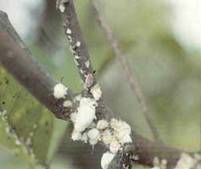Irish Peach and Zouches Pipin.Yield: April – May
Carrington and Winterstein.
Yield: June – July
Rome Beauty, Parlin‘s Beauty and KKL 1.
Yield: August – September.
Soil –
Climate –
One year old grafts on M.778 and M.779 rootstocks during June – July.
June to December.
4 x 4 m in pits of 60 cm x 60 cm x 60 cm.
Water the plants till establishment
Apply FYM 25 kg. N 500 g and 1 kg in each of P and K per bearing tree.
1.Scab : Venturia inaequalis

Symptoms
Management
S.No | Tree stage | Fungicide/100 lit |
1 | Silver tip to given tip | Captafol 200 gm (or) Captan 300 g or Mancozeb 400 g |
2 | Pink bud or 15 days after 1 st spray | Captan 250 g or Mancozeb 300 g |
3 | Petal fall | Carbendazim 50 g |
4 | 10 days later | Captan 200 g.or Mancozeb 300g |
5 | 14 days after fruit set | Captofol 150 g |
2.Powdery mildew: Podosphaera leucotricha

Symptom
Management
3.Fire blight: Erwinia amylovora

Symptom
Management
4.Soft rot: Penicillium expansum

Symptom
5.Bitter rot : Glomerella cingulata

Symptom
Management
1.Wooly aphids – Eriosoma lanigerum

Symptoms of damage:
| Insecticide | Dose |
| Chlorpyrifos 20%EC | 2.5 ml/lit. |
| Malathion 50%EC | 1.0 ml/lit. |
| Oxydemeton –Methyl 25% EC | 1.0 ml/lit. |
| Quinalphos 25%EC | 2.0 ml/lit. |
2.San Jose scale: Quadraspidiotus perniciosus

Symptoms of damage:
Management:
3.Codling moth : Cydia (=Carpocapsa) pomonella
|
4.Cottony cushion scale: Icerya purchasi

Symptoms of damage:
Management :
5.Stem borer: Apriona cinera
|
10 – 20 kg / tree / year. The tree starts bearing from 4th year of planting.
